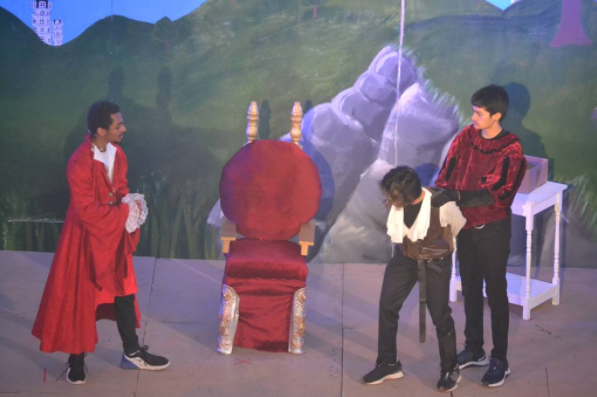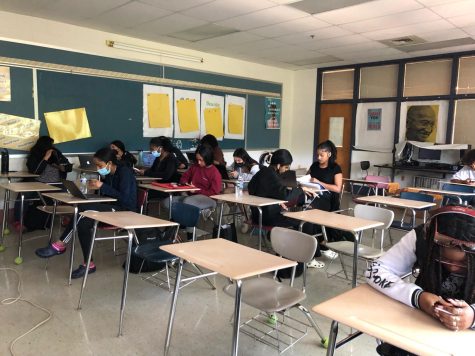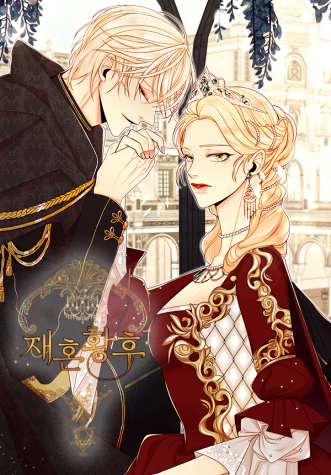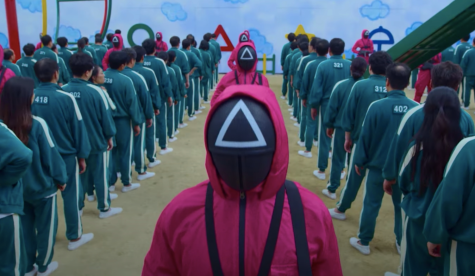Thoughts on the Three Musketeers Play

photo by Daniel Ramirez
A scene when D’Artagnan gets captured by Cardinal Richelieu.
Originally, I didn’t plan on going to the Three Musketeers play. However, the day before the first show, I convinced myself that I should attend at least one play before I graduate. I attended the play with no expectations and hoped that it would pleasantly surprise me—and it definitely did.
One of my concerns was the weather. The play was held outside due to COVID-19 restrictions, so I knew I had to prepare myself for the cold environment. Fortunately, I decided to go to the second showing on Saturday at noon and the weather wasn’t as uncomfortable as I thought it would be. The audience was offered accommodations such as blankets, hot chocolate, and other various snacks and drinks at the concession stands. Although many would assume that the weather would hinder their enjoyment of the play, I believe that the weather unintentionally added to the experience. The slightly cold breeze occasionally carried a rain of leaves, which made the scenes even more captivating to watch. I expected the audience to be fairly small, but a reasonable amount of people—just enough to fill the two rows of chairs—turned up. The previous plays were usually held inside the spacious auditorium, but having the audience gather outside in the cold brought our shared reactions together, making the performance entertaining despite the absence of a big crowd.
Another concern I had regarding the play was the storyline. I initially thought I was going to be quite bored since The Three Musketeers gave me the impression of a serious and plot-heavy narrative. I couldn’t have been more wrong. Very quickly, I found myself invested in the story and its characters. The play kicks off with a fencing scene between the main character, D’Artagnan, and his father, a retired musketeer. We soon learn D’Artagnan’s dream of becoming a musketeer and his rather idealistic way of thinking. Shortly after, we are introduced to a new character—who wasn’t in the original story— named Sabine, the lively and mischievous younger sister of D’Artagnan. The siblings’ banter and dynamic made the audience unable to resist enjoying and laughing at their bond.
Soon after, they go to Paris and while Sabine is off excitedly exploring the city, D’Artagnan recklessly gets into trouble and finds himself scheduling consecutive duels with Athos, Aramis, and Porthos (each of the three musketeers). While D’Artagnan’s cluelessness is revealed during this hilarious disaster, we start to develop a better understanding of his character. Around this time, D’Artagnan also saves his future love interest named Constance Bonacieux. These lighthearted scenes pull in the audience’s attention and lead them to the main conflict of the story—political intrigue. The villain, Cardinal Richelieu, seeks to usurp power from King Louis XIII and schemes behind his back alongside Milady, the Countess de Winter. D’Artagnan and Sabine find themselves caught up in the middle of this conflict and team up with the three musketeers to stop the Cardinal and his men. The Cardinal’s plans were ultimately ruined and during their joyous celebration, D’Artagnan eventually gets promoted as a musketeer. The play finally concludes with all the musketeers, with the addition of D’Artagnan, putting their swords together and shouting, “All for one—” and Sabine jumping in to finish, “and one for all!” The courage and teamwork displayed throughout the story lifted the audience’s spirits and seeing D’Artagnan achieve his big dream of becoming a musketeer left me feeling content.
I grew increasingly invested as the story progressed. Despite some acting and technical slip-ups, the strengths overpowered the weaknesses. The convincing acting, which included the audience in the story at times, impressed me the most. Although some line deliveries weren’t clearly enunciated, the actors’ realistic performances made it easy to overlook. The comedic moments throughout the story, even the unintentional ones, made the play even more worthwhile. For example, at one point in the play, a play assistant was supposed to bring an important prop to the main character on the stage. After calling their name a few times to no avail, one of the actors commented, “I guess I’ll get it myself,” and hustled backstage to get the designated prop quickly. The audience laughed at the unexpected error, yet the actors’ ability to improvise and continue after unexpected mistakes made me increasingly reverent of their professionalism.
Even though this year’s play was overlooked by the majority of students, I’m glad that I took the time to appreciate the hard work of everyone involved, especially the cast and crew. Lensa Dugassa, a crew and cast member who played the Countess de Winter, comments, “It’s really admirable how cohesive and diligent everyone is in preparing the show. I really enjoyed being able to work in both crew and cast.” To anyone who is still hesitant on whether or not to attend future plays, I highly recommend joining the audience for the experience and I can’t wait to see what comes next.










